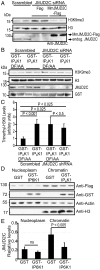Inositol pyrophosphates regulate JMJD2C-dependent histone demethylation
- PMID: 24191012
- PMCID: PMC3839729
- DOI: 10.1073/pnas.1309699110
Inositol pyrophosphates regulate JMJD2C-dependent histone demethylation
Abstract
Epigenetic modifications of chromatin represent a fundamental mechanism by which eukaryotic cells adapt their transcriptional response to developmental and environmental cues. Although an increasing number of molecules have been linked to epigenetic changes, the intracellular pathways that lead to their activation/repression have just begun to be characterized. Here, we demonstrate that inositol hexakisphosphate kinase 1 (IP6K1), the enzyme responsible for the synthesis of the high-energy inositol pyrophosphates (IP7), is associated with chromatin and interacts with Jumonji domain containing 2C (JMJD2C), a recently identified histone lysine demethylase. Reducing IP6K1 levels by RNAi or using mouse embryonic fibroblasts derived from ip6k1(-/-) knockout mice results in a decreased IP7 concentration that epigenetically translates to reduced levels of trimethyl-histone H3 lysine 9 (H3K9me3) and increased levels of acetyl-H3K9. Conversely, expression of IP6K1 induces JMJD2C dissociation from chromatin and increases H3K9me3 levels, which depend on IP6K1 catalytic activity. Importantly, these effects lead to changes in JMJD2C-target gene transcription. Our findings demonstrate that inositol pyrophosphate signaling influences nuclear functions by regulating histone modifications.
Keywords: inositides; metabolism; phosphorylation.
Conflict of interest statement
The authors declare no conflict of interest.
Figures





Similar articles
-
Cooperative demethylation by JMJD2C and LSD1 promotes androgen receptor-dependent gene expression.Nat Cell Biol. 2007 Mar;9(3):347-53. doi: 10.1038/ncb1546. Epub 2007 Feb 4. Nat Cell Biol. 2007. PMID: 17277772
-
Jmjd1a and Jmjd2c histone H3 Lys 9 demethylases regulate self-renewal in embryonic stem cells.Genes Dev. 2007 Oct 15;21(20):2545-57. doi: 10.1101/gad.1588207. Genes Dev. 2007. PMID: 17938240 Free PMC article.
-
JMJD2C promotes colorectal cancer metastasis via regulating histone methylation of MALAT1 promoter and enhancing β-catenin signaling pathway.J Exp Clin Cancer Res. 2019 Oct 29;38(1):435. doi: 10.1186/s13046-019-1439-x. J Exp Clin Cancer Res. 2019. PMID: 31665047 Free PMC article.
-
Inositol pyrophosphates: between signalling and metabolism.Biochem J. 2013 Jun 15;452(3):369-79. doi: 10.1042/BJ20130118. Biochem J. 2013. PMID: 23725456 Review.
-
Insights into the roles of inositol hexakisphosphate kinase 1 (IP6K1) in mammalian cellular processes.J Biol Chem. 2024 Apr;300(4):107116. doi: 10.1016/j.jbc.2024.107116. Epub 2024 Feb 24. J Biol Chem. 2024. PMID: 38403246 Free PMC article. Review.
Cited by
-
ITPK1 Regulates Jasmonate-Controlled Root Development in Arabidopsis thaliana.Biomolecules. 2023 Sep 9;13(9):1368. doi: 10.3390/biom13091368. Biomolecules. 2023. PMID: 37759768 Free PMC article.
-
Histone demethylase JMJD2C: epigenetic regulators in tumors.Oncotarget. 2017 Jul 12;8(53):91723-91733. doi: 10.18632/oncotarget.19176. eCollection 2017 Oct 31. Oncotarget. 2017. PMID: 29207681 Free PMC article. Review.
-
Adipocyte-specific deletion of Ip6k1 reduces diet-induced obesity by enhancing AMPK-mediated thermogenesis.J Clin Invest. 2016 Nov 1;126(11):4273-4288. doi: 10.1172/JCI85510. Epub 2016 Oct 4. J Clin Invest. 2016. PMID: 27701146 Free PMC article.
-
Inositol hexakisphosphate kinase 3 promotes focal adhesion turnover via interactions with dynein intermediate chain 2.Proc Natl Acad Sci U S A. 2019 Feb 19;116(8):3278-3287. doi: 10.1073/pnas.1817001116. Epub 2019 Feb 4. Proc Natl Acad Sci U S A. 2019. PMID: 30718399 Free PMC article.
-
Regulation of Hematopoietic Cell Development and Function Through Phosphoinositides.Front Immunol. 2018 May 4;9:931. doi: 10.3389/fimmu.2018.00931. eCollection 2018. Front Immunol. 2018. PMID: 29780388 Free PMC article. Review.
References
-
- Kouzarides T. Chromatin modifications and their function. Cell. 2007;128(4):693–705. - PubMed
-
- Martin C, Zhang Y. The diverse functions of histone lysine methylation. Nat Rev Mol Cell Biol. 2005;6(11):838–849. - PubMed
-
- Shi Y, et al. Histone demethylation mediated by the nuclear amine oxidase homolog LSD1. Cell. 2004;119(7):941–953. - PubMed
-
- Tsukada Y, et al. Histone demethylation by a family of JmjC domain-containing proteins. Nature. 2006;439(7078):811–816. - PubMed
Publication types
MeSH terms
Substances
Grants and funding
LinkOut - more resources
Full Text Sources
Other Literature Sources
Molecular Biology Databases

